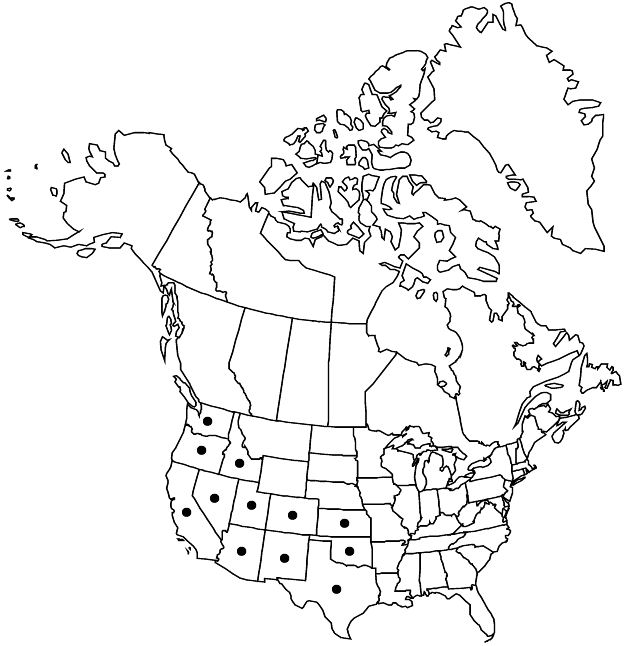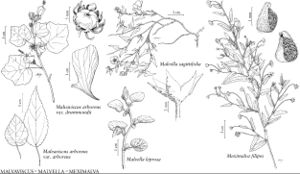Difference between revisions of "Malvella leprosa"
Bonplandia (Corrientes) 3: 59. 1970.
FNA>Volume Importer |
FNA>Volume Importer |
||
| Line 22: | Line 22: | ||
|name=Disella hederacea | |name=Disella hederacea | ||
|authority=(Douglas) Greene | |authority=(Douglas) Greene | ||
| − | }}{{Treatment/ID/Synonym | + | }} {{Treatment/ID/Synonym |
|name=M. hederacea | |name=M. hederacea | ||
|authority=Douglas | |authority=Douglas | ||
| − | }}{{Treatment/ID/Synonym | + | }} {{Treatment/ID/Synonym |
|name=M. sulphurea | |name=M. sulphurea | ||
|authority=Gillies ex Hooker & Arnott | |authority=Gillies ex Hooker & Arnott | ||
| − | }}{{Treatment/ID/Synonym | + | }} {{Treatment/ID/Synonym |
|name=Malvastrum sulphureum | |name=Malvastrum sulphureum | ||
|authority=(Gillies ex Hooker & Arnott) Grisebach | |authority=(Gillies ex Hooker & Arnott) Grisebach | ||
| − | }}{{Treatment/ID/Synonym | + | }} {{Treatment/ID/Synonym |
|name=Sida hederacea | |name=Sida hederacea | ||
|authority=(Douglas) Torrey ex A. Gray | |authority=(Douglas) Torrey ex A. Gray | ||
| − | }}{{Treatment/ID/Synonym | + | }} {{Treatment/ID/Synonym |
|name=S. leprosa | |name=S. leprosa | ||
|authority=(Ortega) K. Schumann | |authority=(Ortega) K. Schumann | ||
| − | }}{{Treatment/ID/Synonym | + | }} {{Treatment/ID/Synonym |
|name=S. sulphurea | |name=S. sulphurea | ||
|authority=(Gillies ex Hooker & Arnott) A. Gray | |authority=(Gillies ex Hooker & Arnott) A. Gray | ||
| Line 55: | Line 55: | ||
|elevation=800–1500 m | |elevation=800–1500 m | ||
|distribution=Ariz.;Calif.;Colo.;Idaho;Kans.;Nev.;N.Mex.;Okla.;Oreg.;Tex.;Utah;Wash.;Mexico (Baja California;Chihuahua;Coahuila;Durango;San Luis Potosí;Sinaloa;Sonora);South America (Argentina;Chile;Peru;Uruguay). | |distribution=Ariz.;Calif.;Colo.;Idaho;Kans.;Nev.;N.Mex.;Okla.;Oreg.;Tex.;Utah;Wash.;Mexico (Baja California;Chihuahua;Coahuila;Durango;San Luis Potosí;Sinaloa;Sonora);South America (Argentina;Chile;Peru;Uruguay). | ||
| − | |discussion=<p>Malvella leprosa is possibly introduced in Colorado. The species is considered to be a noxious weed in Arizona and California and increasing as saline soils increase.</p> | + | |discussion=<p><i>Malvella leprosa</i> is possibly introduced in Colorado. The species is considered to be a noxious weed in Arizona and California and increasing as saline soils increase.</p> |
|tables= | |tables= | ||
|references= | |references= | ||
| Line 79: | Line 79: | ||
|publication year=1970 | |publication year=1970 | ||
|special status=Selected by author to be illustrated;Weedy | |special status=Selected by author to be illustrated;Weedy | ||
| − | |source xml=https://jpend@bitbucket.org/aafc-mbb/fna-data-curation.git/src/ | + | |source xml=https://jpend@bitbucket.org/aafc-mbb/fna-data-curation.git/src/8f726806613d60c220dc4493de13607dd3150896/coarse_grained_fna_xml/V6/V6_547.xml |
|subfamily=Malvaceae subfam. Malvoideae | |subfamily=Malvaceae subfam. Malvoideae | ||
|genus=Malvella | |genus=Malvella | ||
Revision as of 17:48, 18 September 2019
Stems prostrate, indument mixture of stellate and appressed, sublepidote hairs. Leaves: petiole 1/2–1 times as long as blade; blade ± reniform, 1–3.5 cm, wider than long, base obliquely truncate, margins serrate, apex obtuse or subacute, surfaces densely hairy, hairs appressed, sublepidote and stellate. Pedicels long, subequal to subtending petiole; involucellar bractlets 3, inconspicuous, filiform, or 0. Flowers: calyx 8–10 mm, with mixture of stellate and appressed sublepidote hairs, lobes ovate, bases not plicate-overlapping, apex acuminate; petals pale yellow, sometimes with rose flush on fading, asymmetric, 12–15 mm; stamens pallid, glabrous, staminal column antheriferous at apex; style 7–10-branched, pallid, glabrous. Schizocarps 7 mm diam. 2n = 22, 32.
Phenology: Flowering year-round in warmer areas.
Habitat: Heavy, saline soil
Elevation: 800–1500 m
Distribution

Ariz., Calif., Colo., Idaho, Kans., Nev., N.Mex., Okla., Oreg., Tex., Utah, Wash., Mexico (Baja California, Chihuahua, Coahuila, Durango, San Luis Potosí, Sinaloa, Sonora), South America (Argentina, Chile, Peru, Uruguay).
Discussion
Malvella leprosa is possibly introduced in Colorado. The species is considered to be a noxious weed in Arizona and California and increasing as saline soils increase.
Selected References
None.
